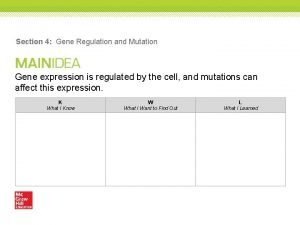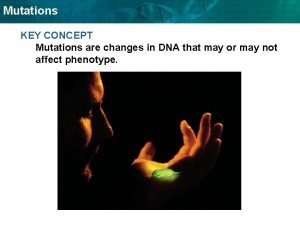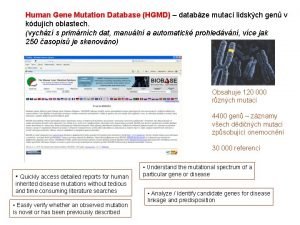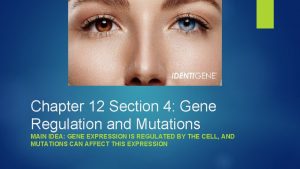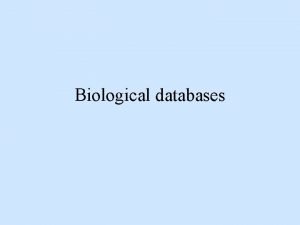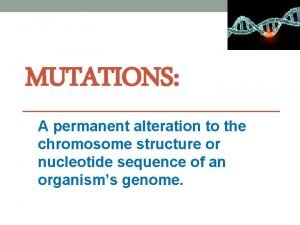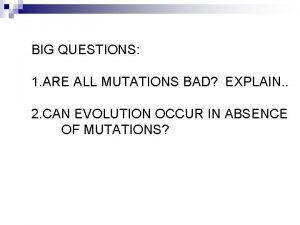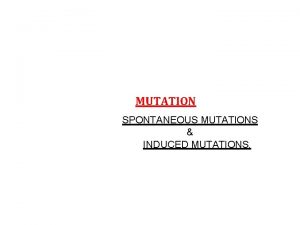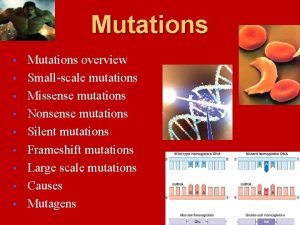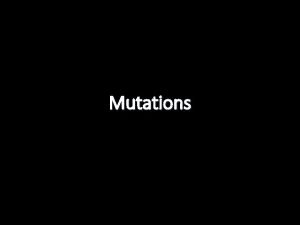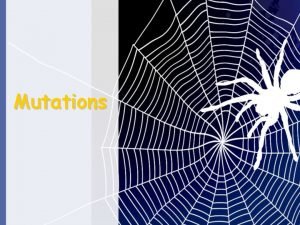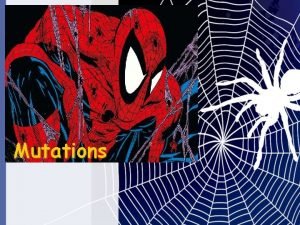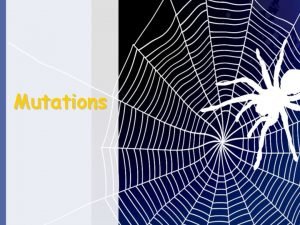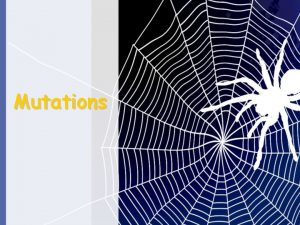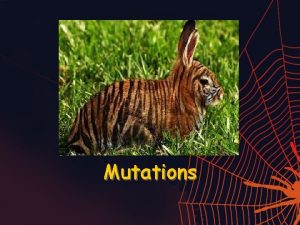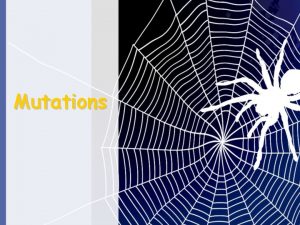Gene Mutations n Changes to the nucleotide sequence














- Slides: 14

Gene Mutations n Changes to the nucleotide sequence of the genetic material of an organism. n Dr. Timmel

Mutations arise when the sequence of nucleotides within an organisms nucleic acids is changed. n The impact of these mutations on the organism can range from life threatening to completely inconsequential. n Mutations are random, though some risky behaviors can put an individual at a greater danger of a mutation. n

The good, the bad and the ugly. n n Mutations are an important ingredient to theory of evolution by natural selection, as they increase the amount of genetic diversity in a population. Usually (>99%) mutations are deleterious (bad) to an organism. However, on occasion, a mutation gives an individual a selective advantage, and will increase in frequency within a population. Mutations will never, ever give you superpowers.

What causes mutations? n n Agents that can cause mutations are called MUTAGENS. Some examples are: 1. 2. 3. Chemicals (Such as the ones in cigarette smoke) Ultra-violet or ionizing radiation Viruses

Types of genetic mutations. n There are two main categories of mutation. Point mutations and frame shift mutations. In a point mutation, a single nitrogen base is substituted with another. e. g. Normal gene =ATA CCG GCA TTA Mutated gene =ATA CCG TCA TTA In this example, a guanine base has been substituted with a thymine.

Outcomes of point mutations n There are three possible outcomes of a point mutation. 1. Silent mutation: The mutated codon codes for the same amino acid. The protein will be unchanged. n For instance, if the codon AAA is mutated to AAG there will be no difference in the protein that is translated. That is because both AAA and AAG code for the same amino acid.

Point mutations cont. 2. Small change mutation(missense mutation): A single amino acid in a protein will be different. The protein will function, but not as well as an unmutated one. Sickle-cell anemia is the result of this type of point mutation n In this disease, a codon which normally would code for Valine is mutated into one that codes for Glutamic Acid.

Point mutations (cont. ) 3. The stop command mutation (nonsense mutations): The mutation causes a codon that would have coded for an amino acid to instead code for the stop command. This will lead to incomplete protein fragments that will not function.

Types of genetic mutation (cont. ) 2. Frame shift mutations: A nitrogen base is either added (insertion) or removed (deleted) from a gene. Normal gene: ATA CGG CTA TTC Insertion: ATA CGA GCT ATT C Deletion: ATA CGC TAT TC (a guanine was deleted)

Results of a frame shift mutation Except in the case of the stop command point mutation, frame shift mutations are much worse than point mutations. n In a gene that has been afflicted with a frame shift mutation, it is unaffected prior to the location of the mutation, but then completely garbled afterwards. n Lets look at an analogy to help illustrate this. n

Frame shift analogy Consider the following sentence: n “The fat cat sat and ate rat”. n This represents the normal gene. Each 3 letter word represents a codon in the gene. n Now let us consider what happens in an insertion mutation. Lets insert a “a” between the t in “cat” and the s in “sat”. n The gene would now look like this n

Insertion cont. The fat cat asa tan dat era t As you can see, the portion of the gene before the insertion is unchanged, but from the location of the insertion onwards, the gene is now nonsense. This gene will not translate into a useable protein. n

Deletion A deletion also causes a frameshift, and just like in an insertion, everything from that point will be altered. n Let’s delete the S from sat in our example. n Now it looks like this. n The cat ata nda atr at n

Can mutations be passed on to your children? Yes, but only if the occur in the sperm or egg cells. n These types of cells are referred to as sex cells, or germ cells. n Mutations that occur in your body cells, which are also known as somatic cells, are not passed on to your children. n
 Amino acid nucleotide
Amino acid nucleotide Section 4 gene regulation and mutations
Section 4 gene regulation and mutations Gene mutations
Gene mutations Gene mutations
Gene mutations Chapter 12 section 4 gene regulation and mutations
Chapter 12 section 4 gene regulation and mutations Ddbj database
Ddbj database Gene by gene test results
Gene by gene test results Chapter 17 gene expression from gene to protein
Chapter 17 gene expression from gene to protein Physical reaction
Physical reaction Changes in latitudes, changes in attitudes meaning
Changes in latitudes, changes in attitudes meaning A permanent alteration that changes a dna sequence
A permanent alteration that changes a dna sequence Are all mutations bad? explain
Are all mutations bad? explain Mutagens
Mutagens Cancer mutations
Cancer mutations Cancer mutations
Cancer mutations

